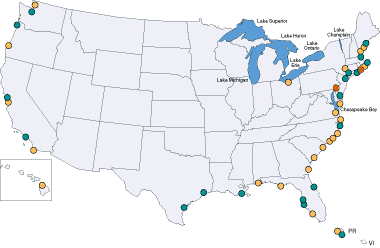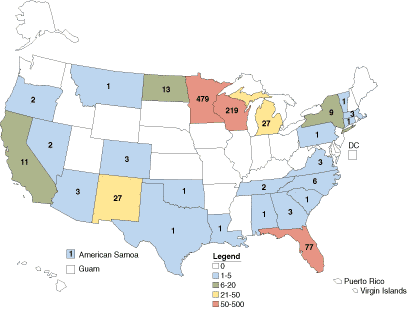The Great Waters Program
The Program
Introduction to the Issues and Ecosystems
As part of the Great Waters Program, Congress requires EPA, in cooperation with the National Oceanic and Atmospheric Administration, to:
- monitor hazardous pollutants by establishing sampling networks
- investigate the deposition of these pollutants
- improve monitoring methods
- monitor for these hazardous pollutants in fish and wildlife
- determine the contribution of air pollution to total pollution in the Great Waters
- evaluate any adverse effects to public health and the environment
- determine sources of pollution
- provide a report to Congress in 1993 and every 2 years

Legend
Great Waters designated by
Clean Air Act
EPA National Estuary Program
Sites
NOAA NEERS Sites*
EPA and NOAA NEERS Sites
*NOAA - National Oceanic and Atmospheric Administration
NERRS - National Estuarine Research Reserve System
Atmospheric deposition can occur in three steps:
- Pollutants are released into the air from man-made or natural sources. Man-made sources include industrial stacks, municipal incinerators, pesticide applications, and vehicle exhaust. Natural sources can be volcanic eruptions, windblown gases spray.
- Pollutants released to the air are carried by continental wind patterns away from their areas of origin. Depending on weather conditions and the chemical and physical properties of the pollutants, they can be carried varying distances from their sources and can undergo physical and chemical changes as they travel.
- Air pollutants are deposited to the earth or directly to waterbodies by either wet or dry deposition. Wet deposition occurs when pollutants are removed from the air by falling rain or snow. Dry deposition occurs when particles settle out of the air by gravity or when gases are transferred directly from the air into water. Air pollutants that deposit on land can be carried into a waterbody by stormwater runoff.
The Clean Air Act requires the establishment of monitoring networks to collect data to help identify and track movement of air pollutants into Great Waters ecosystems and determine overall pollution loadings from the air. EPA must report the findings of the investigations in their biennial reports to Congress. These reports provide an information base that can be used to:
- establish whether air pollution is a significant contributor to water quality problems of the Great Waters
- determine whether there are significant adverse effects to humans or the environment
- evaluate the effectiveness of existing regulatory programs in addressing these problems
- determine whether additional regulatory actions are needed
to reduce atmospheric deposition to the Great Waters.
Fish Consumption Warnings for Mercury

There is widespread evidence in the United States, Canada, and Europe of high concentrations of mercury, a toxic metal, in fish tissue that exceed local, national, or international public health guidelines. This contamination represents a serious human health concern as well as a significant economic threat to both the commercial and sportfishing industries.
Currently 27 states have consumption advisories for specific waterbodies warning consumers about mercury-contaminated fish and shellfish (see map). Many of these advisories, particularly in Minnesota, Wisconsin, and Florida, have been issued for relatively pristine waterbodies where atmospheric deposition is thought to be the main source of the mercury contamination.
Mercury comes from natural and man-made sources. Natural
sources of atmospheric mercury include degassing of the earth's
crust and forest fires. Major man-made sources of atmospheric
mercury include combustion of coal and other fossil fuels,
incineration of municipal refuse, and evaporation from surfaces
painted with mercury-containing paints.

